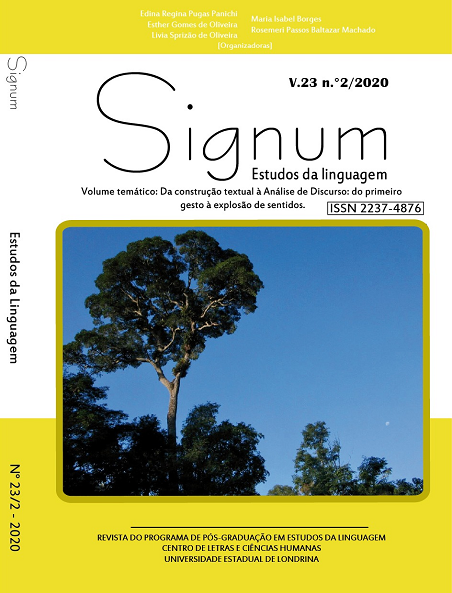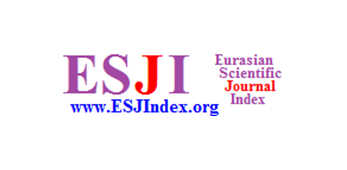Modelling Translation as a Theatre of the Mind: reporting clauses and inward affect
DOI:
https://doi.org/10.5433/2237-4876.2020v23n2p23Palavras-chave:
translation theatrics, emotional (self)performance, inward affect.Resumo
Este artigo defende que o tradutor literário trabalha sobre a obra original expressando interiormente suas emoções e sentimentos sob máscaras de personagens. Suas escolhas lexicais são indicativas de sua performance interior, cujas subjetividades íntimas são visíveis quando em contraste com a linguagem de outros tradutores. Para sustentar meu ponto de que a tradução literária é emocionalmente performativa e acontece no estado de transição psicológica entre o Outro ficcional e múltiplos Eus, bem como entre mimese e autotese, explorarei a possibilidade de modelá-la como um teatro da mente por meio do contraste semântico dos verbos dicendi encontrados no primeiro capítulo de O Som e a Fúria, de William Faulkner, e suas seis traduções em russo, polonês, lituano, romeno e francês.
Downloads
Referências
ARMSTRONG, G. Theatre as a complex adaptive system. New Theatre Quarterly, Cambridge, v. 13, n. 51, p. 277-288, jan. 1997. Disponível em: http://bit.ly/3tZaump.
BAER, B. J. The translator's biography and the politics of representation. In: WOODSWORTH, J. (ed.). The fictions of translation. Amsterdam; Philadelphia: John Benjamins, 2018. p. 50-66.
BAKER, H. T. Literature and the emotions. The English Journal, v. 16, n. 10, p. 772-777, jan. 1927. Disponível em: https://bit.ly/3qqmxHf. Acesso em: 05 dec. 2020.
BARBA, E. The genesis of theatre anthropology. Tradução Christopher Cairns e Judy Barba. New Theatre Quarterly, Cambridge, v. 10, n. 38, p. 167-173, jan. 1994. Disponível em: http://bit.ly/3dfXenr.
BLEIKASTEN, A. An Easter without resurrection? In: BLOOM, H. (ed.). William Faulkner's The Sound and the Fury. New York, NY: Bloom's Literary Criticism, 2008. p. 41-66.
BOAL, A. Theatre, human beings. In: KEEFE J.; MURRAY S. (ed.). Physical theatres: A critical reader. London; New York: Routledge, 2007. p. 32-37.
COTTER, S. The Soviet translation: Romanian literary translators after World War Two. Meta, v. 53, n. 4, p. 841-859, dez. 2008. Disponível em: http://bit.ly/3b69c0t.
CULLER, J. Literary theory: A very short introduction. Oxford: Oxford University Press, 2000.
DANYTÄ–, M. LiteratÅ«rinio vertimo normų pokyÄiai Lietuvoje po 1990-ųjų metų. Kalbų Studijos, n. 12, p. 51-56, 2008. Disponível em: https://bit.ly/3u4Tsnc.
DAWKINS, R. The selfish gene: 30th anniversary edition. Oxford: Oxford University Press, 2006.
DENETT, D. Consciousness explained. New York; London: Back Bay Books, 1991.
FALLETTI, C. Introduction: The shared space of action. In: FALLETTI C.; SOFIA, G.; JACONO, V. (ed.). Theatre and cognitive neuroscience. London; New York: Bloomsbury Methuen Drama, 2016. p. 3-14.
FRIEDHEIM, P. Wagner and the aesthetics of the scream. 19th-Century Music, v. 7, n. 1, p. 63-70, 1983. Disponível em: https://bit.ly/3u10RDR.
GARCIA-ROMEU, A. Self-transcendence as a measurable transpersonal construct. The Journal of Transpersonal Construct, v. 42, n. 1, p. 26-47, 2010.
GLAVIN, J. Dickens and theatre. In: JORDAN, J. O. (ed.). The Cambridge companion to Charles Dickens. Cambridge: Cambridge University Press, 2001. p. 189-203.
GOLDSTEIN, T. R.; BLOOM, P. The mind on stage: Why cognitive scientists should study acting. Trends in Cognitive Sciences, v. 15, n. 4, p. 141-142, mar. 2011. Disponível em: http://bit.ly/3qkdrMa.
GORELICK, S. Translator's introduction. In: MALLARMÉ, S. The book. Tradução Sylvia Gorelick. Cambridge: Exact Change, 2018. p. v-xvi.
GOSSMAN, L. The signs of the theatre. Theatre Research International, v. 2, n. 1, p. 1-15, jan. 1976. Disponível em: https://bit.ly/37f90KY.
HARTMANN, E. Thin and thick boundaries: Personality, dreams, and imagination. In: KUNZENDORF, R. G. (ed.). Mental imagery. New York, NY: Springer Science+Business Media, 1991. p. 71-78.
LAI-MING, T. H. Reading aloud in Dickens' novel. Oral Tradition, v. 23, n. 2, p. 185-199, out. 2008. Disponível em: https://bit.ly/3bcQ7tm.
LAKOFF, G.; JOHNSON, M. Metaphors we live by. Chicago; London: University of Chicago Press, 2003.
LAVIOSA, S.; PAGANO, A.; KEMPPANEN, H.; JI, M. Textual and contextual analysis in empirical translation studies. Singapore: Springer Science+Business Media, 2017.
MALMKJÆR, K. Norms and nature in translation studies. SYNAPS, v. 16, p. 13-19, 2005.
MORRISON, G. M. The composition of The Sound and the Furry. In: BLOOM, H. (ed.). William Faulkner's The Sound and the Fury. New York, NY: Bloom's Literary Criticism, 2008. p. 3-30.
NATOLI, J. Mots d'ordre: Disorder in literary worlds. Albany, NY: State University of New York, 1992.
PAGE, N. Speech in the English novel. 2. ed. London: The Macmillan Press, 1988.
PAVILAVIÄŒIŪTE, G. Translation as a barrier between the original narrative and the reader: A case study of power relations and address forms in two crim fiction novels. Darnioji DaugiakalbystÄ— | Sustainable Multilingualism, n. 15, p 147-169, 2019. Disponível em: http://bit.ly/3bcVOaG.
PLATTEN, R. L. From Sketches to Nickleby. In: JORDAN, J. O. (ed.). The Cambridge companion to Charles Dickens. Cambridge: Cambridge University Press, 2001. p. 16-33.
SCHECHNER, R. Between theatre and anthropology. Philadelphia, PA: University of Pennsylvania, 1985.
SCHECHNER, R. Performance theory. 2. ed. London: Routledge, 1988. SHERRY, S. Discourses of regulation and resistance: censoring translation in the Stalin and Khrushchev era Soviet Union. Edinburgh: Edinburgh University Press, 2015.
STRAVINSKIENÄ–, E. Mano metai; prisiminimai. Vilnius, LT: Garnelis, 2008.
THALBOURNE, M. A.; HOURAN, J. Transliminality, the mental experience inventory and tolerance of ambiguity. Personality and Individual Differences, v. 28, n. 5, p. 853-863, maio 2000. Disponível em: http://bit.ly/3ppUg2h.
VENCLOVA, T. Translations of world literature and political censorship in contemporary Lithuania. Lituanus, v. 25, n. 2, 1979. Disponível em: http://bit.ly/3qoCTQM.
VENUTI, L. The translator's invisibility: A history of translation. London; New York: Routledge, 1995.
VERMA, N. Theatre of the mind: Imagination, aesthetics, and American radio drama. Chicago; London: The University of Chicago Press, 2012.
WATSON, J. G. William Faulkner: Self-presentation and performance. Austin, TX: University of Texas Press, 2002.
YOUNG, J. Sergei Dovlatov and his narrative masks. Evanston: Northwestern University Press, 2009.
YOUNG, K.; SAVER, J. L. The neurology of narrative. Substance, v. 30, n. 1/2, f. 94-95, p.72-84, 2001. (Special Issue: On the Origin of Fictions: Interdisciplinary Perspectives). Disponível em: https://bit.ly/3dhJoRM.
Downloads
Publicado
Como Citar
Edição
Seção
Licença
Copyright (c) 2021 Signum: Estudos da Linguagem

Este trabalho está licenciado sob uma licença Creative Commons Attribution-NonCommercial-NoDerivatives 4.0 International License.
Signum: Estudos da linguagem, publica seus artigos licenciados sob a Licença Atribuição-NãoComercial-CompartilhaIgual 4.0 Internacional. Esta licença permite que terceiros façam download e compartilhem os trabalhos em qualquer meio ou formato, desde que atribuam o devido crédito de autoria, mas sem que possam alterá-los de nenhuma forma ou utilizá-los para fins comerciais. Se você remixar, transformar ou desenvolver o material, não poderá distribuir o material modificado.

















